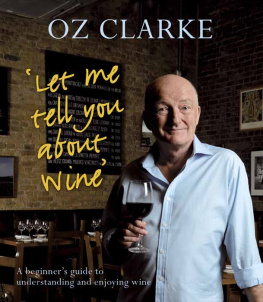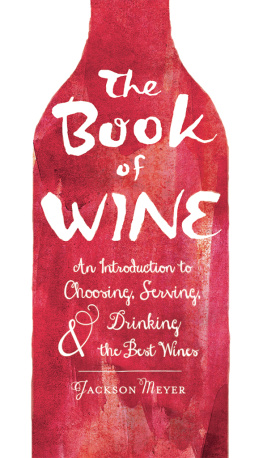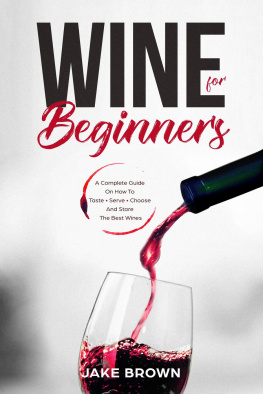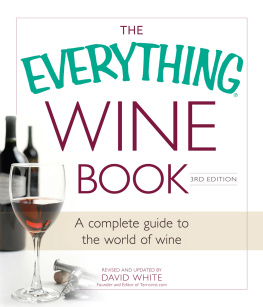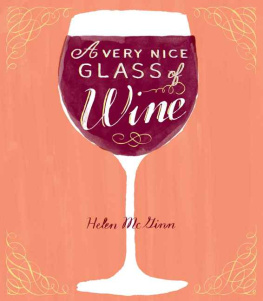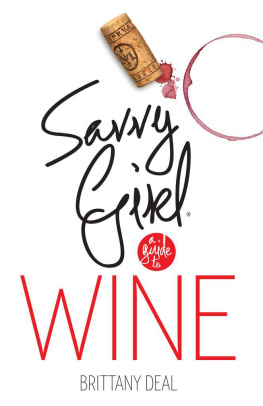THE
EVERYTHING
GUIDE TO
WINE
All you need to know about buying, storing, serving,
and enjoying the world's most remarkable wines
Peter Alig
Wine Educator at Robert Mondavi Winery

Copyright 2010 by F+W Media, Inc.
All rights reserved.
This book, or parts thereof, may not be reproduced
in any form without permission from the publisher; exceptions
are made for brief excerpts used in published reviews.
An Everything Series Book.
Everything and everything.com are registered trademarks of F+W Media, Inc.
Published by Adams Media, a division of F+W Media, Inc.
57 Littlefield Street, Avon, MA 02322 U.S.A.
www.adamsmedia.com
ISBN 10: 1-4405-0748-1
ISBN 13: 978-1-4405-0748-9
eISBN 10: 1-4405-0749-X
eISBN 13: 978-1-4405-0749-6
Printed in the United States of America.
10 9 8 7 6 5 4 3 2 1
Library of Congress Cataloging-in-Publication Data
is available from the publisher.
This publication is designed to provide accurate and authoritative information with regard to the subject matter covered. It is sold with the understanding that the publisher is not engaged in rendering legal, accounting, or other professional advice. If legal advice or other expert assistance is required, the services of a competent professional person should be sought.
From a Declaration of Principles jointly adopted by a Committee of the
American Bar Association and a Committee of Publishers and Associations
Many of the designations used by manufacturers and sellers to distinguish their products are claimed as trademarks. Where those designations appear in this book and Adams Media was aware of a trademark claim, the designations have been printed with initial capital letters.
Contains material adapted and abridged from The Everything Wine Book, 2nd Edition, by Barbara Nowak and Beverly Wichman, copyright 1997, 2005 by F+W Media, Inc, ISBN 10:1-59337-357-0, ISBN 13: 978-1-59337-357-3.
Sidebar wine bottle, wine glass, and grape art istockphoto / aerobaby
Sidebar corkscrew art istockphoto / fckuen
This book is available at quantity discounts for bulk purchases.
For information, please call 1-800-289-0963.
THE EVERYTHING GUIDE TO WINE
Dear Reader,
When I first went to work for a winery in its hospitality department, I had a wine certification under my belt and a desire to help visitors understand and enjoy wine as much as I did. Then one day a guest asked me a question about our vineyard I could not answer. I apologized profusely, but the guest simply smiled encouragingly, patted me on the back, and we continued our tour.
The guest turned out to be an established winemaker from Germany, someone who knew much more about wine than I did. The way he responded to my ignorance taught me something valuable about the wine industry as a whole: Wine and generosity of spirit seem to go hand in hand. Those who work in the industry bring great passion to their professions as well as a desire to share what they know with others.
This book is a product of that spirit. After reading it, I hope you become inspired to ask questions, taste something unfamiliar, and share your newfound knowledge with others. Even if you don't work in the wine industry itself, you can embody everything it stands for.
Cheers!

Welcome to the EVERYTHING Series!
These handy, accessible books give you all you need to tackle a difficult project, gain a new hobby, comprehend a fascinating topic, prepare for an exam, or even brush up on something you learned back in school but have since forgotten.
You can choose to read an Everything book from cover to cover or just pick out the information you want from our four useful boxes: e-questions, e-facts, e-alerts, and e-ssentials. We give you everything you need to know on the subject, but throw in a lot of fun stuff along the way, too.
We now have more than 400 Everything books in print, spanning such wide-ranging categories as weddings, pregnancy, cooking, music instruction, foreign language, crafts, pets, New Age, and so much more. When you're done reading them all, you can finally say you know Everything!

Connoisseur's class notes

The sommelier speaks

Tasting tips and tricks

Facts for wine lovers
PUBLISHER Karen Cooper
DIRECTOR OF ACQUISITIONS AND INNOVATION Paula Munier
MANAGING EDITOR, EVERYTHING SERIES Lisa Laing
COPY CHIEF Casey Ebert
ACQUISITIONS EDITOR Katrina Schroeder
SENIOR DEVELOPMENT EDITOR Brett Palana-Shanahan
EDITORIAL ASSISTANT Ross Weisman
EVERYTHING SERIES COVER DESIGNER Erin Alexander
LAYOUT DESIGNERS Colleen Cunningham, Elisabeth Lariviere, Ashley Vierra, Denise Wallace
Visit the entire Everything series at www.everything.com
Acknowledgments
My greatest thanks go to the people of Robert Mondavi Winery, especially Jocelyn Hoar, Anne LeBlanc, Sanda Manuila, Inger Shiffler, and Dana Andrus, who continue to inspire me with their passion and commitment to excellence. I am also indebted to the insights of my teachers along the way: Paul Wagner of Balzac Communications, Paul Mabray of Vintank, Bryan Avila of Nappa Valley College, and Karen MacNeil of the Culinary Institute of America.
Special thanks are also in order for my dear family, who gave me their blessing to go west to play the game of wine. Cheers to you all!
Top 10 Wine Myths
Aged wine is better than young wine.
Not all wines need aging. Generally speaking, red wines particularly those high in tannins require more aging than whites.
Red wine should never be chilled.
Some light reds, like Beaujolais, benefit from chilling.
Reserve wines are top of the line.
Reserve on American wine labels has no legal meaning. Winemakers can use the term at their whim.
Wines with sulfites will give you a headache.
Sulfites are the cause of headaches in only about 1 percent of the population mostly asthmatics.
All German wines are sweet.
German wines come in all degrees of sweetness from dry to very, very sweet. Trocken on a German wine label means dry.
Screw tops are a sign of cheap wine.
Au contraire! Increasingly, top winemakers are using screw tops to avoid cork contamination of their wines.
Wines should always breathe.
In general, breathing is only necessary for wines that need further aging.
All wines have the same amount of alcohol.
The level of alcohol depends on the amount of sugar that has been converted during fermentation.


